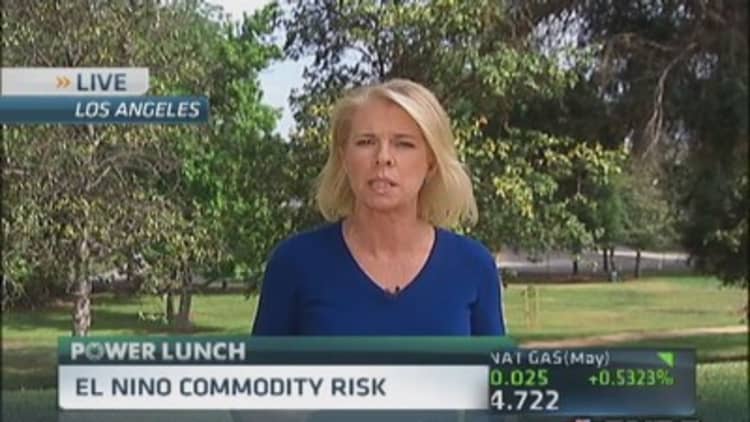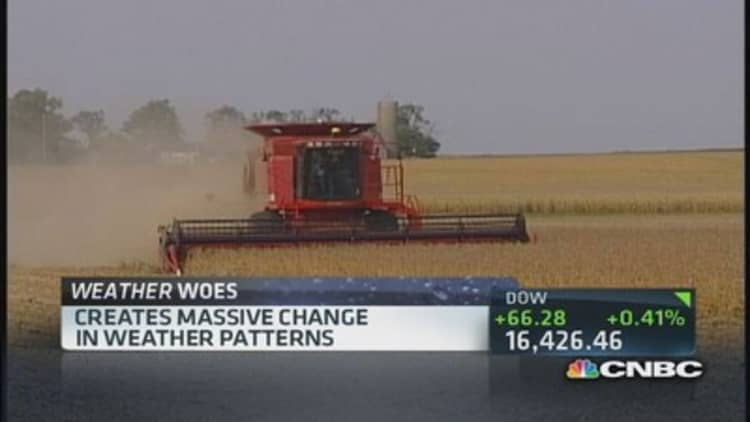It is so dry in California that the U.S. Department of Agriculture recently reported that 94 percent of the state's massive $45 billion farm economy is suffering from severe to "exceptional" drought.
That could change—dramatically.
"The odds are stacked that we will see a return for the first time in five years to El Niño in the summer or fall of 2014," said USDA meteorologist Brad Rippey. "Odds are in the ballpark of one-half to two-thirds likelihood."
El Niño is a weather phenomenon that begins with warming waters in the eastern Pacific. It often creates drought in much of Asia and Australia, with cooler and wetter weather in North America. "For U.S. agriculture in very general terms, El Niño is a rainmaker," Rippey said.
Read More
That should be good for farmers across the country, leading to higher yields for things such as corn, soybeans and cotton. As for California, Rippey said if an El Niño is strong enough, it could eradicate years of drought in one season. It's happened before.
"Some of the historically strong El Niños—1982-83, 1997-98—the hallmark of those were flooding rains and heavy mountain snowfall across much of California."
The '82-'83 El Niño caused an estimated 2,000 deaths globally and $13 billion in damage, according to National Geographic, but the most memorable pictures may have been oceanfront mansions in Malibu being swept away. "That was scary," actress Dyan Cannon said at the time as waves crashed through her home. "I panicked."

However, a quick end to drought in the western United States would have a variety of benefits. Lower corn and soybeans prices would mean lower costs to feed livestock. That eventually could bring down meat prices from their current record highs.
CLSA, a brokerage firm out of Asia, said that could be beneficial for meat producers. Already this year, shares of Tyson Foods and Pilgrims Pride are up more than 25 percent. CLSA also said an El Niño would cause "a significant dislocation in agricultural production, which is good for grain merchants, such as Bunge."
That's because although crops may do well in the United States and also in South America, drought elsewhere could drive up demand. Prices could also rise for wheat, palm oil, cocoa and coffee. Those are just some of the commodities Michael Haigh of Societe Generale tracks in an El Niño Commodity Index. If predictions come true, "Starting this summer we should see some pretty significant effects on the commodity markets," he said.
Read More El Nino threatens to return, hit global food production
For example, Haigh said that despite a potential bumper crop of soybeans in this hemisphere, problems elsewhere could drive up demand. "You get situations, for instance, where fish swimming patterns change as a result off these events, so it's harder to catch them, and there's less fish meal available to feed animals, so soybean meal is substituted."

Among other changes Haigh said we may see:
Lower heating costs. "You tend to have milder winters (in the U.S.)...so that squashes any sort of price spike on the oil side."
Fewer hurricanes. "That alleviates some of the damage you might get there, and hence price shocks to the energy sector."
Potential metals shortages if torrential rains flood South American mines. "Famously in '97-'98, I believe it was, that Peru and Ecuador had seven years' worth of rainfall confined to a four-month period. And so these mines were flooded, and hence production was cut off and prices spiked."
Read MoreTime to 'get real' on climate change: EU official
He thinks nickel may be more at risk than copper, as nickel supplies already are expected to be lighter than normal this year, potentially affecting everything from batteries to stainless steel prices.
Haigh said if investors went long on his portfoliio of commodities when NOAA called an official El Niño, and then shorted or went neutral when meteorologists declared the event over, they'd be right 71 percent of the time. "It's nothing earth-shattering. It's just a simple algorithm."
It may be too soon to test that theory. Whether El Niño arrives or not is still uncertain, and even if it does, meteorologist Rippey isn't sure how strong it will be.
"Every El Niño has its own flavor," he said.
—By CNBC's Jane Wells


